Submitted:
15 January 2024
Posted:
17 January 2024
You are already at the latest version
Abstract
Keywords:
1. Introduction
2. Materials and Methods
2.1. Study Area
2.2. Data Sources
2.2.1. Sampling Survey and Primary Sample Units (PSUs)
2.2.2. Land Use/Cover Change (LUCC) Dynamics
2.3. Methods
2.3.1. The CSLE Model
2.3.2. Non-Homogeneous Voting and LUCC Optimization
3. Results
3.1. Soil Erosion Pattern of Yunnan Based on Sampling Survey and Field Investigation
3.1.1. Investigated Land Parcel Basics of Yunnan in the NSES
3.1.2. Soil Erosion Rate Variations under Different Land Use Types and Topography
3.1.3. Impact of Engineering Conservation Measures on Cropland Soil Erosion
3.2. Land Use Change Dynamics in Yunnan from 2000 to 2020
3.3. Cropland Soil Erosion Dynamics in Yunnan from 2000 to 2020
4. Discussion
5. Conclusions
Author Contributions
Funding
Data Availability Statement
Acknowledgments
Conflicts of Interest
References
- Banwart, S. Save our soils. Nature 2011, 474(7350), 151–152. [Google Scholar] [CrossRef]
- Banwart, S.A.; Nikolaidis, N.P.; Zhu, Y.G. Soil functions: connecting earth's critical zone. Annual Review of Earth and Planetary Sciences 2019, 47, 333–359. [Google Scholar] [CrossRef]
- Lehmann, J.; Bossio, D.A.; Kögel-Knabner, I. The concept and future prospects of soil health. Nature Reviews Earth & Environment 2020, 1(10), 544–553. [Google Scholar] [CrossRef]
- Borrelli, P.; Robinson, D.A.; Fleischer, L.R. An assessment of the global impact of 21st century land use change on soil erosion. Nature communications 2017, 8(1), 2013. [Google Scholar] [CrossRef] [PubMed]
- Ascough, J.C.; Flanagan, D.C.; Tatarko, J. Soil erosion modeling and conservation planning. Precision Conservation: Geospatial techniques for agricultural and natural resources conservation 2017, 59, 1–25. [Google Scholar]
- Wuepper, D.; Borrelli, P.; Finger, R. Countries and the global rate of soil erosion. Nature sustainability 2020, 3(1), 51–55. [Google Scholar] [CrossRef]
- Montgomery, D.R. Soil erosion and agricultural sustainability. Proceedings of the National Academy of Sciences 2007, 104(33), 13268–13272. [Google Scholar] [CrossRef] [PubMed]
- Morgan, R.P.C. Soil erosion and conservation. John Wiley & Sons 2009, 15-22.
- Boardman, J. How much is soil erosion costing us? Geography 2021, 106(1), 32–38. [Google Scholar] [CrossRef]
- Wang, Z.; Hoffmann, T.; Six, J. Human-induced erosion has offset one-third of carbon emissions from land cover change. Nature Climate Change 2017, 7(5), 345–349. [Google Scholar] [CrossRef]
- Alewell, C.; Ringeval, B.; Ballabio, C. Global phosphorus shortage will be aggravated by soil erosion. Nature communications 2020, 11(1), 4546. [Google Scholar] [CrossRef]
- Li, J.; Xiong, M.; Sun, R. Temporal variability of global potential water erosion based on an improved USLE model. International Soil and Water Conservation Research 2024, 12(1), 1–12. [Google Scholar] [CrossRef]
- Borrelli, P.; Ballabio, C.; Yang, J.E. GloSEM: High-resolution global estimates of present and future soil displacement in croplands by water erosion. Scientific Data 2022, 9(1), 406. [Google Scholar] [CrossRef]
- Pimentel, D.; Burgess, M. Soil erosion threatens food production. Agriculture 2013, 3(3), 443–463. [Google Scholar] [CrossRef]
- Shanshan, W.; Baoyang, S.; Chaodong, L. Runoff and soil erosion on slope Cropland: A Review. Journal of Resources and Ecology 2018, 9(5), 461–470. [Google Scholar] [CrossRef]
- Xiong, M.; Sun, R.; Chen, L. A global comparison of soil erosion associated with land use and climate type. Geoderma 2019, 343, 31–39. [Google Scholar] [CrossRef]
- Boardman, J. Soil erosion science: Reflections on the limitations of current approaches. Catena 2006, 68(2-3), 73–86. [Google Scholar] [CrossRef]
- De, V.J.; Poesen, J.; Verstraeten, G. Predicting soil erosion and sediment yield at regional scales: where do we stand? Earth-Science Reviews 2013, 127, 16–29. [Google Scholar]
- Vrieling, A. Satellite remote sensing for water erosion assessment: A review. Catena 2006, 65(1), 2–18. [Google Scholar] [CrossRef]
- Alewell, C.; Borrelli, P.; Meusburger, K. Using the USLE: Chances, challenges and limitations of soil erosion modelling. International soil and water conservation research 2019, 7(3), 203–225. [Google Scholar] [CrossRef]
- Laflen, J.M.; Flanagan, D.C. The development of US soil erosion prediction and modeling. International Soil and Water Conservation Research 2013, 1(2), 1–11. [Google Scholar] [CrossRef]
- Xie, Y.; Zhao, Y.; Zhang, Y. History and current situation of soil erosion survey in the United States. Soil and Water Conservation in China 2013, (10), 53–60. [Google Scholar]
- Borrelli P, Alewell C, Alvarez P. Soil erosion modelling: A global review and statistical analysis. Science of the total environment 2021, 780, 146494. [CrossRef] [PubMed]
- Renard K G. Predicting soil erosion by water: a guide to conservation planning with the Revised Universal Soil Loss Equation (RUSLE). US Department of Agriculture, Agricultural Research Service 1997, 234.
- Flanagan, D.C.; Gilley, J.E.; Franti, T.G. Water Erosion Prediction Project (WEPP): Development history, model capabilities, and future enhancements. Trans. ASABE 2007, 50, 1603–1612. [Google Scholar] [CrossRef]
- Guo, Y.; Peng, C.; Zhu, Q. Modelling the impacts of climate and land use changes on soil water erosion: Model applications, limitations and future challenges. Journal of environmental management 2019, 250, 109403. [Google Scholar] [CrossRef]
- Benavidez, R.; Jackson, B.; Maxwel, l.D. A review of the (Revised) Universal Soil Loss Equation ((R) USLE): With a view to increasing its global applicability and improving soil loss estimates. Hydrology and Earth System Sciences 2018, 22(11), 6059–6086. [Google Scholar] [CrossRef]
- Olson, K.R.; Gennadiyev, A.N.; Zhidkin, A.P. Use of magnetic tracer and radio-cesium methods to determine past cropland soil erosion amounts and rates. Catena 2013, 104, 103–110. [Google Scholar] [CrossRef]
- Xie, Y.; Yue, Y.T. Application of soil erosion models for soil and water conservation. Sci. Soil Water Conserve 2018, 16, 25–37. (In Chinese) [Google Scholar]
- García-Ruiz, J.M.; Beguería, S.; Nadal-Romero, E. A meta-analysis of soil erosion rates across the world. Geomorphology 2015, 239, 160–173. [Google Scholar] [CrossRef]
- Rompaey, A.J.J.V.; Govers, G. Data quality and model complexity for regional scale soil erosion prediction. International Journal of Geographical Information Science 2002, 16(7), 663–680. [Google Scholar] [CrossRef]
- Nusser, S.M.; Goebel, J.J. The National Resources Inventory: a long-term multi-resource monitoring programme. Environmental and Ecological Statistics 1997, 4, 181–204. [Google Scholar] [CrossRef]
- Liu, B.Y.; Xie, Y.; Li, Z.G.; Liang, Y.; Zhang, W.B.; Fu, S.H.; Yin, S.Q.; Wei, X.; Zhang, K.L.; Wang, Z.Q. The assessment of soil loss by water erosion in China. Int. Soil Water Conserve. Res 2020, 8, 430–439. [Google Scholar] [CrossRef]
- Liu, B.Y.; Guo, S.Y.; Li, Z.G.; Xie, Y.; Zhang, K.L.; Liu, X.C. Sampling survey of water erosion in China. Soil and Water Conservation in China 2013, 01, 26–34. (In Chinese) [Google Scholar]
- Borrelli, P.; Poesen, J.; Vanmaercke, M. Monitoring gully erosion in the European Union: A novel approach based on the Land Use/Cover Area frame survey (LUCAS). International Soil and Water Conservation Research 2022, 10(1), 17–28. [Google Scholar] [CrossRef]
- Matthews, F.; Verstraeten, G.; Borrelli, P. EUSEDcollab: a network of data from European catchments to monitor net soil erosion by water. Scientific data 2023, 10(1), 515. [Google Scholar] [CrossRef] [PubMed]
- Duan, X.; Tao, Y.; Bai, Z. Regional Soil erosion survey methods. Beijing: Science Press 2019, 111-123.
- Yin, S.; Zhu, Z.; Wang, L. Regional soil erosion assessment based on a sample survey and geostatistics. Hydrology and Earth System Sciences 2018, 22(3), 1695–1712. [Google Scholar] [CrossRef]
- Xie, Y.; Lin, H.; Ye, Y. Changes in soil erosion in cropland in northeastern China over the past 300 years. Catena 2019, 176, 410–418. [Google Scholar] [CrossRef]
- Sepuru, T.K.; Dube, T. An appraisal on the progress of remote sensing applications in soil erosion mapping and monitoring. Remote Sensing Applications: Society and Environment 2018, 9, 1–9. [Google Scholar] [CrossRef]
- Wang, J.; Zhen, J.; Hu, W. Remote sensing of soil degradation: Progress and perspective. International Soil and Water Conservation Research 2023, 11(3), 429–454. [Google Scholar] [CrossRef]
- Fenta, A.A.; Tsunekawa, A.; Haregeweyn, N. Improving satellite-based global rainfall erosivity estimates through merging with gauge data. Journal of Hydrology 2023, 620, 129555. [Google Scholar] [CrossRef]
- Chen, Y.; Xu, M.; Wang, Z. Applicability of two satellite-based precipitation products for assessing rainfall erosivity in China. Science of the Total Environment 2021, 757, 143975. [Google Scholar] [CrossRef] [PubMed]
- Angelopoulou, T.; Tziolas, N.; Balafoutis, A. Remote sensing techniques for soil organic carbon estimation: A review. Remote Sensing 2019, 11(6), 676. [Google Scholar] [CrossRef]
- Roering, J.J.; Stimely, L.L.; Mackey, B.H. Using DInSAR, airborne LiDAR, and archival air photos to quantify landsliding and sediment transport. Geophysical Research Letters 2009, 36(19). [Google Scholar] [CrossRef]
- Fendrich, A.N.; Matthews, F.; Van, E.E. From regional to parcel scale: A high-resolution map of cover crops across Europe combining satellite data with statistical surveys. Science of the Total Environment 2023, 873, 162300. [Google Scholar] [CrossRef]
- Feng, Q.; Zhao, W.W. The study on cover-management factor in USLE and RUSLE: A review. Acta Ecologica Sinica 2014, 34(16), 4461–4472. [Google Scholar]
- Ebabu, K.; Tsunekawa, A.; Haregeweyn, N. Global analysis of cover management and support practice factors that control soil erosion and conservation. International Soil and Water Conservation Research 2022, 10(2), 161–176. [Google Scholar] [CrossRef]
- Panagos, P.; Borrelli, P.; Meusburger, K. Modelling the effect of support practices (P-factor) on the reduction of soil erosion by water at European scale. Environmental science & policy 2015, 51, 23–34. [Google Scholar] [CrossRef]
- Zhao, H.; Fang, X.; Ding, H. Extraction of terraces on the Loess Plateau from high-resolution DEMs and imagery utilizing object-based image analysis. ISPRS International Journal of Geo-Information 2017, 6(6), 157. [Google Scholar] [CrossRef]
- Duan, X.; Rong, L.; Bai, Z. Effects of soil conservation measures on soil erosion in the Yunnan Plateau, southwest China. Journal of Soil and Water Conservation 2020, 75(2), 131–142. [Google Scholar] [CrossRef]
- Duan, X.; Bai, Z.; Rong, L. Investigation method for regional soil erosion based on the Chinese Soil Loss Equation and high-resolution spatial data: Case study on the mountainous Yunnan Province, China. Catena 2020, 184, 104237. [Google Scholar] [CrossRef]
- Yang, Y.; Shi, Y.; Liang, X. Evaluation of structure from motion (SfM) photogrammetry on the measurement of rill and interrill erosion in a typical loess. Geomorphology 2021, 385, 107734. [Google Scholar] [CrossRef]
- Panos, P.; Pasquale, B.; Jean, P. The new assessment of soil loss by water erosion in Europe. Environmental Science & Policy 2015, 8, 438–447. [Google Scholar]
- Panagos, P.; Meusburger, K.; Van Liedekerke, M. Assessing soil erosion in Europe based on data collected through a European network. Soil science and plant nutrition 2014, 60(1), 15–29. [Google Scholar] [CrossRef]
- Borrelli, P.; Robinson, D.A.; Panagos, P. Land use and climate change impacts on global soil erosion by water (2015-2070). Proceedings of the National Academy of Sciences 2020, 117(36), 21994–22001. [Google Scholar] [CrossRef] [PubMed]
- Kidane, M.; Bezie, A.; Kesete, N. The impact of land use and land cover (LULC) dynamics on soil erosion and sediment yield in Ethiopia. Heliyon 2019, 5(12), e02981. [Google Scholar] [CrossRef] [PubMed]
- Brandolini, F.; Kinnaird, T.C.; Srivastava, A. Modelling the impact of historic landscape change on soil erosion and degradation. Scientific reports 2023, 13(1), 4949. [Google Scholar] [CrossRef] [PubMed]
- Chalise, D.; Kumar, L. Land use change affects water erosion in the Nepal Himalayas. Plos one 2020, 15(4), e0231692. [Google Scholar] [CrossRef]
- Zhang, Z.; Zhao, X. Remote Sensing monitoring of land use in China. Planet Mapping Press 2012, 99–103. [Google Scholar]
- Wang, X.; Zhao, X.; Zhang, Z. Assessment of soil erosion change and its relationships with land use/cover change in China from the end of the 1980s to 2010. Catena 2016, 137, 256–268. [Google Scholar] [CrossRef]
- Xi, J.; Zhao, X.; Wang, X. Assessing the impact of land use change on soil erosion on the Loess Plateau of China from the end of the 1980s to 2010. Journal of Soil and Water Conservation 2017, 72(5), 452–462. [Google Scholar] [CrossRef]
- Nearing, M.A.; Xie, Y.; Liu, B. Natural and anthropogenic rates of soil erosion. International Soil and Water Conservation Research 2017, 5(2), 77–84. [Google Scholar] [CrossRef]
- Baoyuan, L.; Keli, Z.; Yun, X. An empirical soil loss equation. Proceedings of the 12th International Soil Conservation Organization Conference, Beijing, China 2002, 26-31.
- Chen, G.; Zhang, Z.; Guo, Q. Quantitative assessment of soil erosion based on CSLE and the 2010 national soil erosion survey at regional scale in Yunnan Province of China. Sustainability 2019, 11(12), 3252. [Google Scholar] [CrossRef]
- Sun, H.; Wang, J.; Xiong, J. Vegetation change and its response to climate change in Yunnan Province, China. Advances in Meteorology 2021, 2021, 1–20. [Google Scholar] [CrossRef]
- Thomas, A. The onset of the rainy season in Yunnan province, PR China and its significance for agricultural operations. International journal of biometeorology 1993, 37, 170–176. [Google Scholar] [CrossRef]
- Li, Y.G.; He, D.; Hu, J.M. Variability of extreme precipitation over Yunnan Province, China 1960–2012. International Journal of Climatology 2015, 35(2), 245–258. [Google Scholar] [CrossRef]
- Zhang, Z.; Wang, X.; Zhao, X. A 2010 update of National Land Use/Cover Database of China at 1: 100000 scale using medium spatial resolution satellite images. Remote sensing of environment 2014, 149, 142–154. [Google Scholar] [CrossRef]
- Liu, L.; Zhang, X.; Chen, X. GLC_FCS30-2020: Global Land Cover with Fine Classification System at 30m in 2020. Earth Syst. Sci. Data 2020, 13, 2753–2776. [Google Scholar]
- Yang, J.; Huang, X. The 30 m annual land cover dataset and its dynamics in China from 1990 to 2019. Earth System Science Data 2021, 13(8), 3907–3925. [Google Scholar] [CrossRef]
- Chen, J.; Chen, J.; Liao, A. Global land cover mapping at 30 m resolution: A POK-based operational approach. ISPRS Journal of Photogrammetry and Remote Sensing 2015, 103, 7–27. [Google Scholar] [CrossRef]
- Karra, K.; Kontgis, C.; Statman-Weil, Z. Global land use/land cover with Sentinel 2 and deep learning. 2021 IEEE international geoscience and remote sensing symposium IGARSS. IEEE 2021, 4704–4707. [Google Scholar]
- Zanaga, D.; Van, D.K.R.; Daems, D. ESA WorldCover 10 m 2021 v200. Land 2022, 12(9), 1740. [Google Scholar]
- Liu, Y.; Zhong, Y.; Ma, A. Cross-resolution national-scale land-cover mapping based on noisy label learning: A case study of China. International Journal of Applied Earth Observation and Geoinformation 2023, 118, 103265. [Google Scholar] [CrossRef]
- Brown, C.F.; Brumby, S.P.; Guzder-Williams, B. Dynamic World, Near real-time global 10 m land use land cover mapping. Scientific Data 2022, 9(1), 251. [Google Scholar] [CrossRef]
- Stehman, S.V.; Foody, G.M. Key issues in rigorous accuracy assessment of land cover products. Remote Sensing of Environment 2019, 231, 111199. [Google Scholar] [CrossRef]
- Chen, G.; Wang, Y.; Wen, Q. An Erosion-Based Approach Using Multi-Source Remote Sensing Imagery for Grassland Restoration Patterns in a Plateau Mountainous Region, SW China. Remote Sensing 2023, 15(8), 2047. [Google Scholar] [CrossRef]
- Lu, S.; Duan, X.; Wei, S. An insight to calculate soil conservation service. Geography and Sustainability 2022, 3(3), 237–245. [Google Scholar] [CrossRef]
- Liu, B.Y.; Nearing, M.A.; Risse, L.M. Slope gradient effects on soil loss for steep slopes. Trans. ASAE 1994, 37, 1835–1840. [Google Scholar] [CrossRef]
- Guo, S.Y.; Liu, B.Y. Soil erosion investigation and evaluation. China Water Resources and Hydropower Press 2014, 63–70. (In Chinese) [Google Scholar]
- Wang, W.; He, L.S. Survey and analysis on current situation of slope farmland in Yunnan province. Journal of soil and water conservation 2019, (5), 20–23. (In Chinese) [Google Scholar]


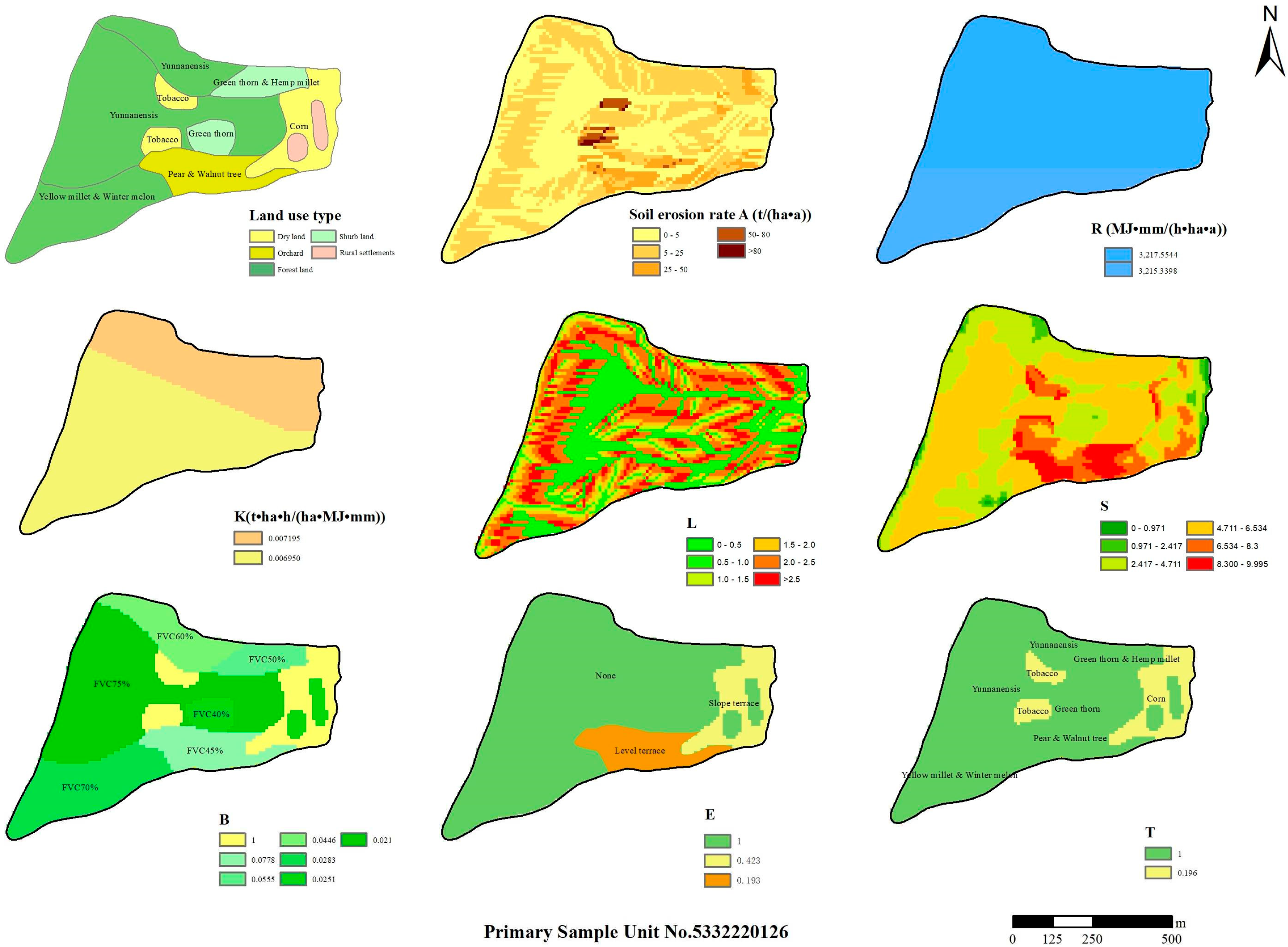
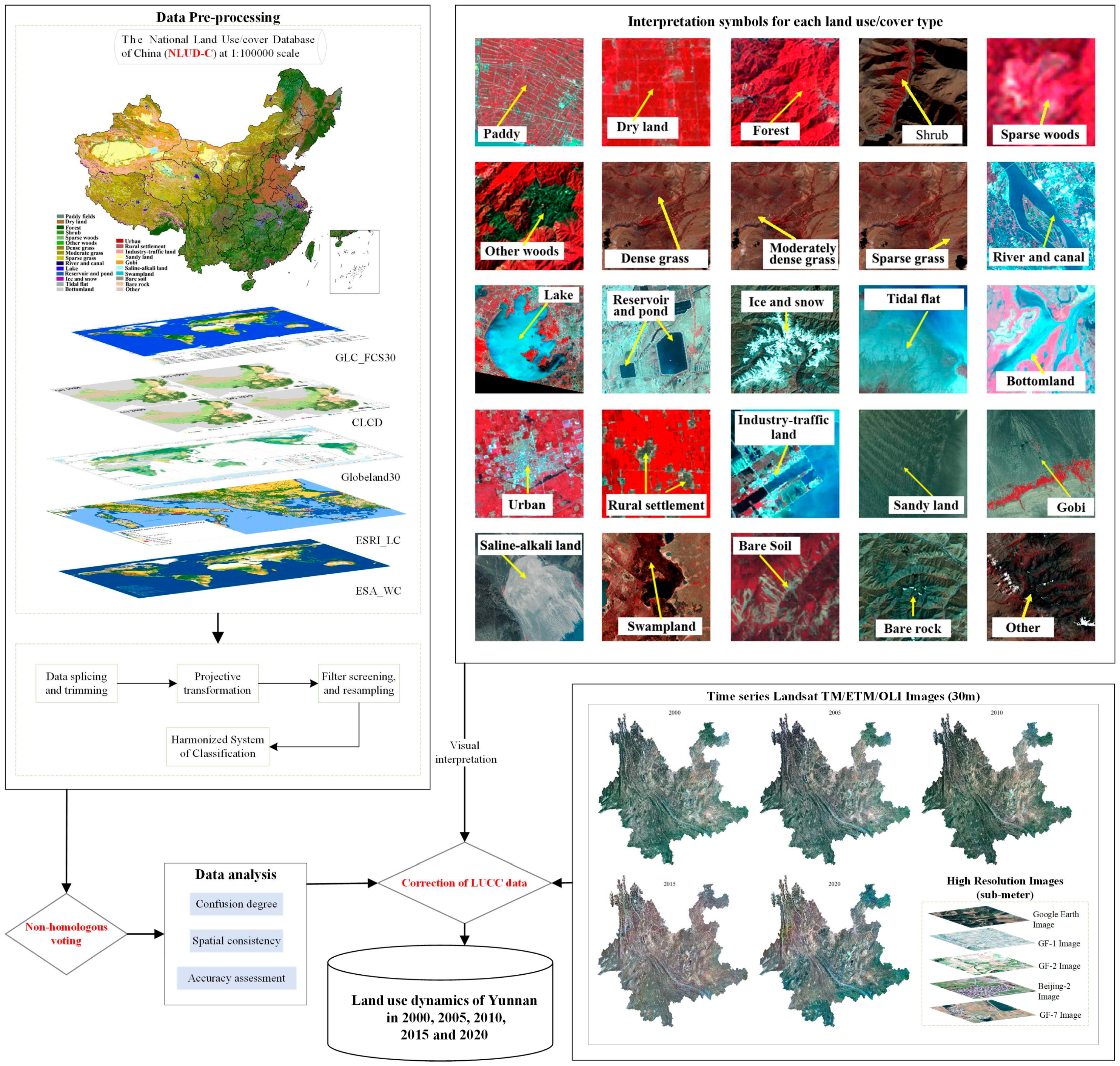

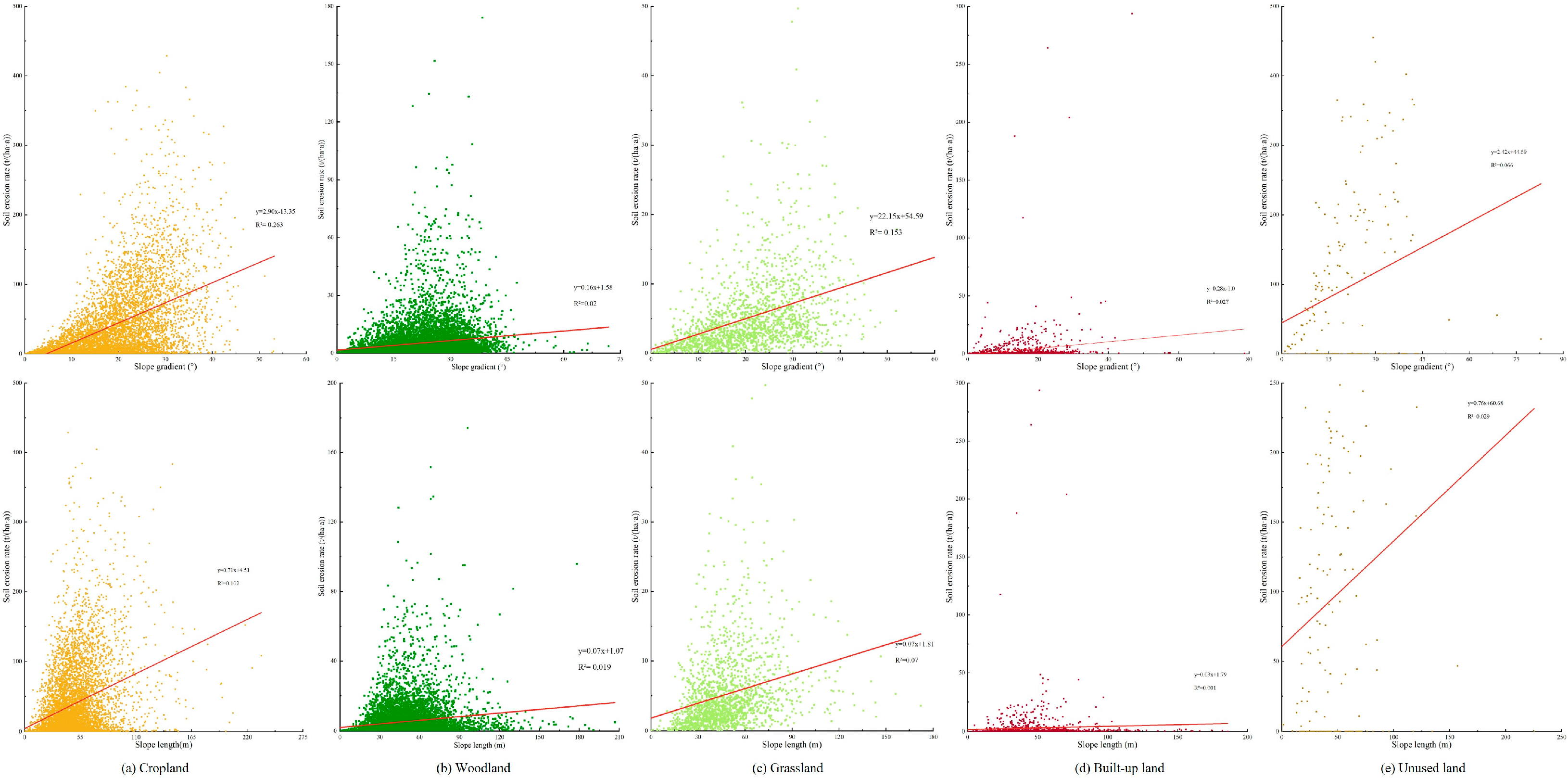

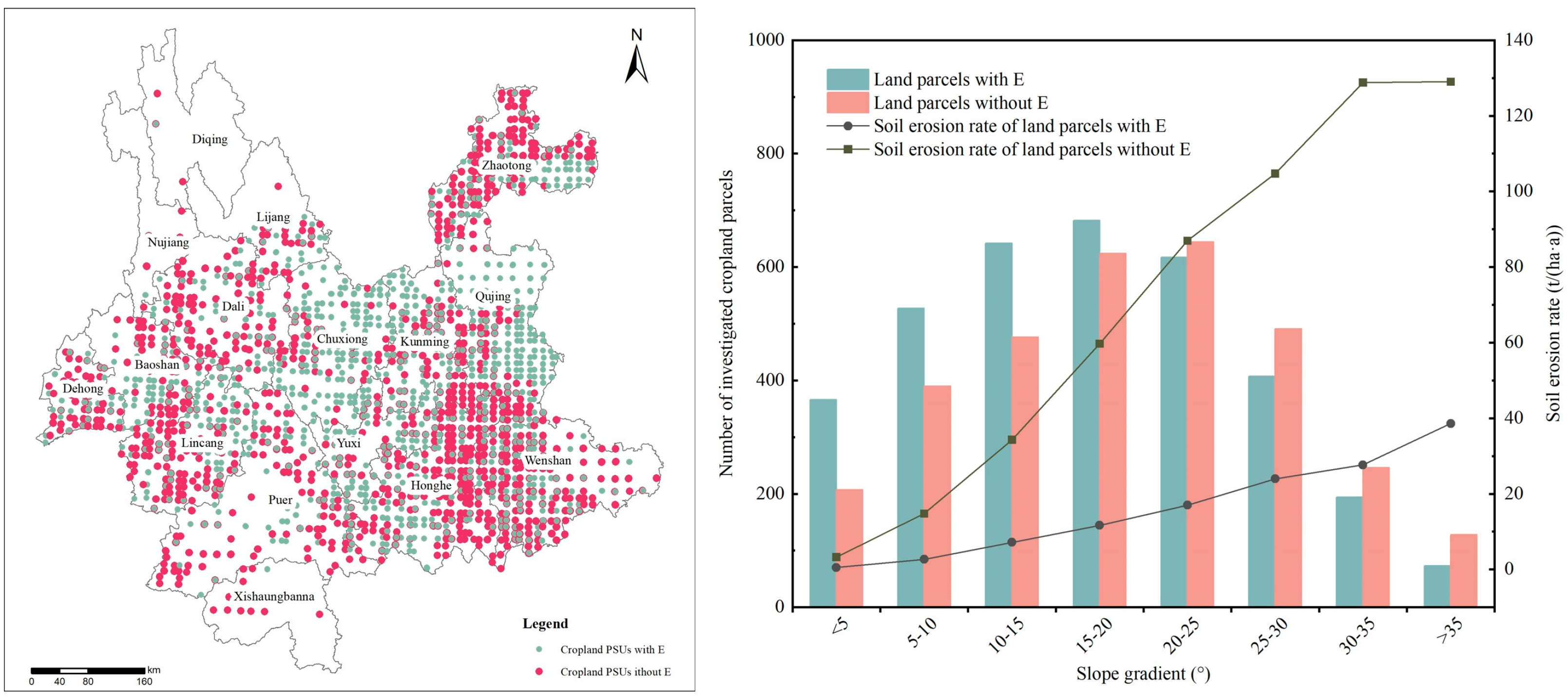

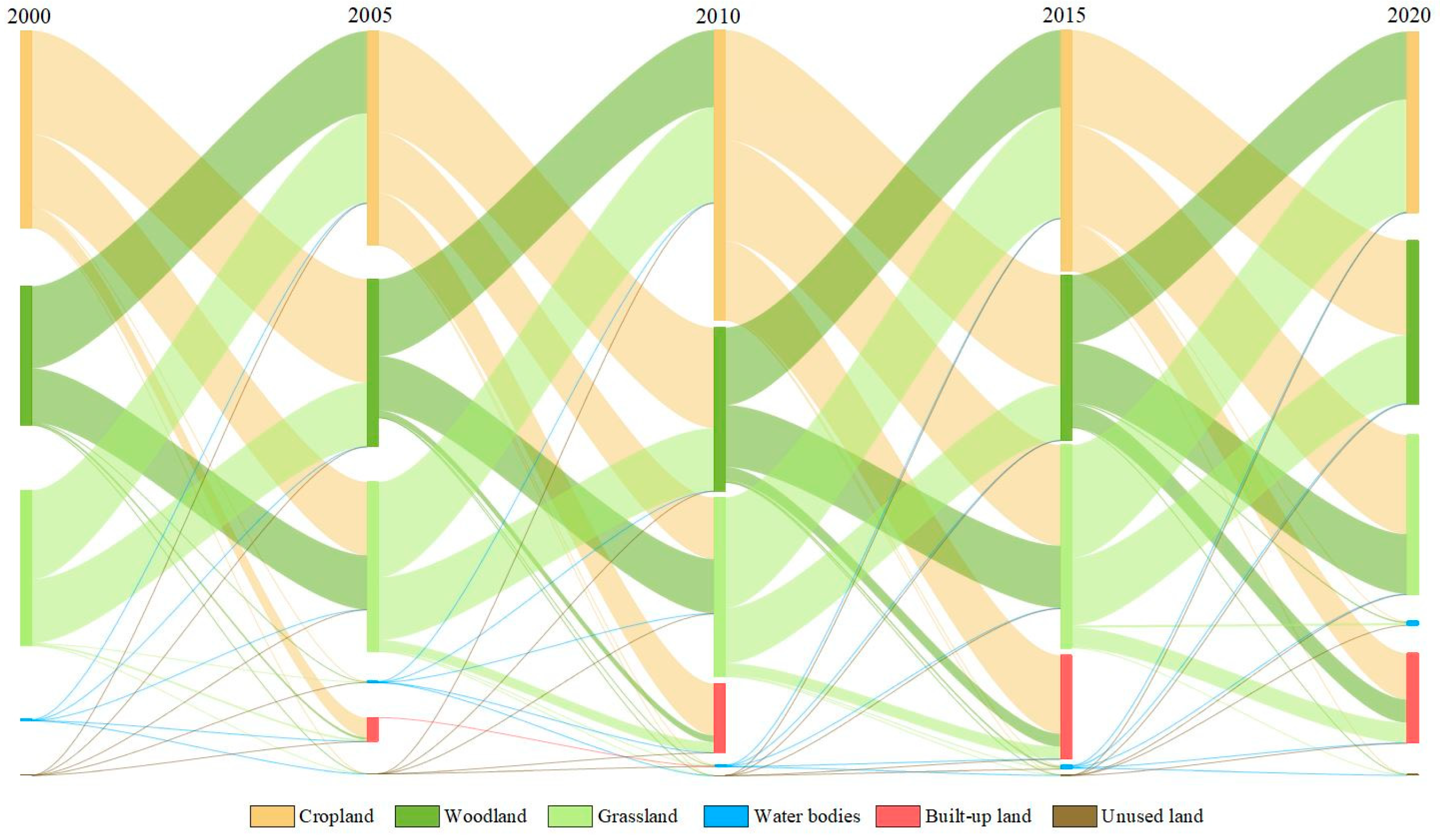



| Datasets | Image Source | Method | Cover | Resolution | OA |
|---|---|---|---|---|---|
| NLUD-C | Landsat TM/ETM | Interactive Interpretation | China | 30m | > 90% |
| GLC_FCS30 | Landsat TM/ETM/OLI | Random Forest | Global | 30m | 82.5% |
| CLCD | Landsat TM/ETM/OLI | Supervisory Algorithm | China | 30m | 79.31% |
| GlobeLand30 | Landsat/HJ-1/GF-1 | POK method | Global | 30m | 85.72% |
| ESRI_LC | Sentinel-2 | Deep learning | Global | 10m | 85% |
| ESA_WC | Sentinel-2 | Random Forest | Global | 10m | 75% |
| CRLC | Sentinel-2 | Deep learning | China | 10m | 84% |
| Dynamic World | Sentinel-2 | Deep learning | Global | 10m | 72% |
| 1st Level Types | NP | APA | Max-PA | Min-PA | ASG | ASL | SEM | SEM Range |
|---|---|---|---|---|---|---|---|---|
| Cropland | 6714 | 2.77 | 81.92 | 0.02 | 17.88 | 47.94 | 40.47 | 0−428.95 |
| Woodland | 10015 | 7.03 | 86.53 | 0.03 | 22.79 | 48.62 | 5.37 | 0−174.12 |
| Grassland | 1742 | 3.05 | 73.16 | 0.02 | 20.84 | 47.85 | 5.16 | 0−49.70 |
| Water bodies | 257 | 1.34 | 18.56 | 0.03 | 4.14 | 21.28 | ― | ― |
| Built-up land | 1237 | 1.33 | 25.01 | 0.01 | 14.02 | 42.96 | 2.95 | 0−293.67 |
| Unused land | 190 | 2.50 | 41.96 | 0.04 | 19.05 | 44.94 | 96.52 | 0−455.15 |
| NLUD-C Land Types | R | K | L | S | B | E | T | A | |
|---|---|---|---|---|---|---|---|---|---|
| 1st Level | 2nd Level | ||||||||
| Cropland | Dryland | 3343.94 | 0.006 | 1.48 | 5.69 | 1 | 0.69 | 0.33 | 45.34 |
| Paddy fields | 3898.49 | 0.005 | 1.25 | 4.37 | 1 | 0.02 | 0.40 | 1.61 | |
| Irrigated land | 2681.28 | 0.006 | 1.15 | 2.17 | 1 | 0.51 | 0.27 | 7.80 | |
| Woodland | Forest | 3485.29 | 0.006 | 1.56 | 3.96 | 0.03 | 1 | 1 | 3.61 |
| Shrub | 3270.27 | 0.006 | 1.57 | 4.16 | 0.04 | 1 | 1 | 4.68 | |
| Sparse woods | 3378.44 | 0.005 | 1.55 | 3.73 | 0.12 | 0.96 | 1 | 14.48 | |
| Gardens | 3825.29 | 0.006 | 1.52 | 6.42 | 0.05 | 0.77 | 0.98 | 6.65 | |
| Grassland | Dense grass | 3569.07 | 0.006 | 1.48 | 3.51 | 0.05 | 0.97 | 1 | 4.89 |
| Moderate grass | 3218.25 | 0.006 | 1.49 | 3.62 | 0.06 | 0.97 | 1 | 5.72 | |
| Sparse grass | 3029.18 | 0.005 | 1.52 | 3.79 | 0.06 | 0.97 | 1 | 5.87 | |
| Water bodies | — | 3147.59 | — | 0.98 | 2.06 | 0 | 1 | 1 | — |
| Built-up land | Rural | 3249.22 | 0.006 | 1.40 | 4.57 | 0.02 | 0.2 | 1 | 1.18 |
| Urban | 3200.18 | 0.006 | 0.91 | 0.71 | 0.01 | 0.09 | 1 | 1.20 | |
| Mining land | 3271.48 | 0.005 | 1.39 | 3.81 | 0.95 | 0.14 | 1 | 18.21 | |
| Unused land | Bare soil | 2945.28 | 0.006 | 1.47 | 5.90 | 1 | 0.98 | 1 | 156.73 |
| Bare rock | 3017.59 | 0.006 | 1.47 | 6.21 | 0 | 0.98 | 1 | 0 | |
| LUCC Scenarios | Honghe | Irrawaddy | Jinsha | Lancang | Nu | Peal |
|---|---|---|---|---|---|---|
| C to F | -46.02 | -31.72 | -24.63 | -65.22 | -52.90 | -28.80 |
| C to G | -44.82 | -29.02 | -23.12 | -64.31 | -48.91 | -28.53 |
| C to W | -50.12 | -34.53 | -29.17 | -69.95 | -57.06 | -33.12 |
| C to R | -43.23 | -28.16 | -27.72 | -66.53 | -55.72 | -29.27 |
| C to U | 64.02 | 101.11 | 63.23 | 93.83 | 115.62 | 54.69 |
Disclaimer/Publisher’s Note: The statements, opinions and data contained in all publications are solely those of the individual author(s) and contributor(s) and not of MDPI and/or the editor(s). MDPI and/or the editor(s) disclaim responsibility for any injury to people or property resulting from any ideas, methods, instructions or products referred to in the content. |
© 2024 by the authors. Licensee MDPI, Basel, Switzerland. This article is an open access article distributed under the terms and conditions of the Creative Commons Attribution (CC BY) license (http://creativecommons.org/licenses/by/4.0/).





